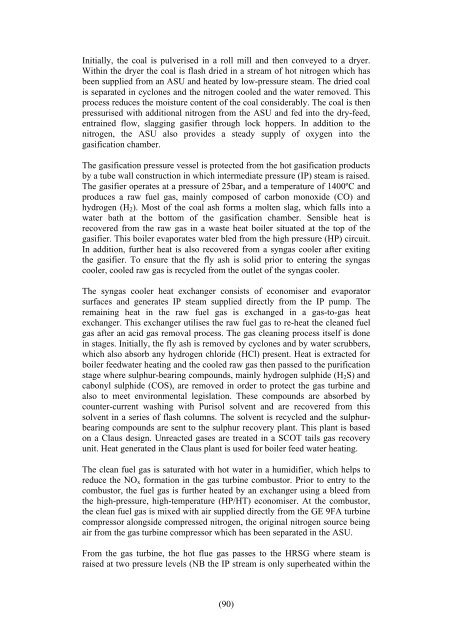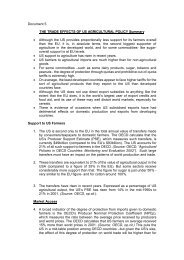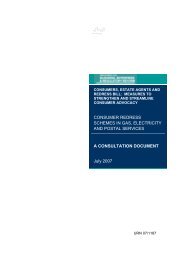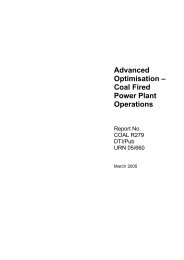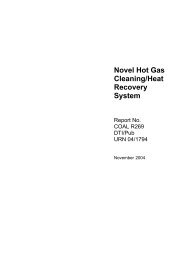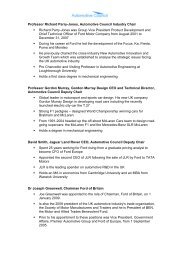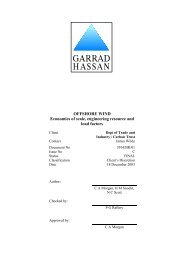(70) Therefore, the risk of sulphuric acid dew point attack ... - DTI Home
(70) Therefore, the risk of sulphuric acid dew point attack ... - DTI Home
(70) Therefore, the risk of sulphuric acid dew point attack ... - DTI Home
You also want an ePaper? Increase the reach of your titles
YUMPU automatically turns print PDFs into web optimized ePapers that Google loves.
Initially, <strong>the</strong> coal is pulverised in a roll mill and <strong>the</strong>n conveyed to a dryer.<br />
Within <strong>the</strong> dryer <strong>the</strong> coal is flash dried in a stream <strong>of</strong> hot nitrogen which has<br />
been supplied from an ASU and heated by low-pressure steam. The dried coal<br />
is separated in cyclones and <strong>the</strong> nitrogen cooled and <strong>the</strong> water removed. This<br />
process reduces <strong>the</strong> moisture content <strong>of</strong> <strong>the</strong> coal considerably. The coal is <strong>the</strong>n<br />
pressurised with additional nitrogen from <strong>the</strong> ASU and fed into <strong>the</strong> dry-feed,<br />
entrained flow, slagging gasifier through lock hoppers. In addition to <strong>the</strong><br />
nitrogen, <strong>the</strong> ASU also provides a steady supply <strong>of</strong> oxygen into <strong>the</strong><br />
gasification chamber.<br />
The gasification pressure vessel is protected from <strong>the</strong> hot gasification products<br />
by a tube wall construction in which intermediate pressure (IP) steam is raised.<br />
The gasifier operates at a pressure <strong>of</strong> 25bara and a temperature <strong>of</strong> 1400ºC and<br />
produces a raw fuel gas, mainly composed <strong>of</strong> carbon monoxide (CO) and<br />
hydrogen (H2). Most <strong>of</strong> <strong>the</strong> coal ash forms a molten slag, which falls into a<br />
water bath at <strong>the</strong> bottom <strong>of</strong> <strong>the</strong> gasification chamber. Sensible heat is<br />
recovered from <strong>the</strong> raw gas in a waste heat boiler situated at <strong>the</strong> top <strong>of</strong> <strong>the</strong><br />
gasifier. This boiler evaporates water bled from <strong>the</strong> high pressure (HP) circuit.<br />
In addition, fur<strong>the</strong>r heat is also recovered from a syngas cooler after exiting<br />
<strong>the</strong> gasifier. To ensure that <strong>the</strong> fly ash is solid prior to entering <strong>the</strong> syngas<br />
cooler, cooled raw gas is recycled from <strong>the</strong> outlet <strong>of</strong> <strong>the</strong> syngas cooler.<br />
The syngas cooler heat exchanger consists <strong>of</strong> economiser and evaporator<br />
surfaces and generates IP steam supplied directly from <strong>the</strong> IP pump. The<br />
remaining heat in <strong>the</strong> raw fuel gas is exchanged in a gas-to-gas heat<br />
exchanger. This exchanger utilises <strong>the</strong> raw fuel gas to re-heat <strong>the</strong> cleaned fuel<br />
gas after an <strong>acid</strong> gas removal process. The gas cleaning process itself is done<br />
in stages. Initially, <strong>the</strong> fly ash is removed by cyclones and by water scrubbers,<br />
which also absorb any hydrogen chloride (HCl) present. Heat is extracted for<br />
boiler feedwater heating and <strong>the</strong> cooled raw gas <strong>the</strong>n passed to <strong>the</strong> purification<br />
stage where sulphur-bearing compounds, mainly hydrogen sulphide (H2S) and<br />
cabonyl sulphide (COS), are removed in order to protect <strong>the</strong> gas turbine and<br />
also to meet environmental legislation. These compounds are absorbed by<br />
counter-current washing with Purisol solvent and are recovered from this<br />
solvent in a series <strong>of</strong> flash columns. The solvent is recycled and <strong>the</strong> sulphurbearing<br />
compounds are sent to <strong>the</strong> sulphur recovery plant. This plant is based<br />
on a Claus design. Unreacted gases are treated in a SCOT tails gas recovery<br />
unit. Heat generated in <strong>the</strong> Claus plant is used for boiler feed water heating.<br />
The clean fuel gas is saturated with hot water in a humidifier, which helps to<br />
reduce <strong>the</strong> NOx formation in <strong>the</strong> gas turbine combustor. Prior to entry to <strong>the</strong><br />
combustor, <strong>the</strong> fuel gas is fur<strong>the</strong>r heated by an exchanger using a bleed from<br />
<strong>the</strong> high-pressure, high-temperature (HP/HT) economiser. At <strong>the</strong> combustor,<br />
<strong>the</strong> clean fuel gas is mixed with air supplied directly from <strong>the</strong> GE 9FA turbine<br />
compressor alongside compressed nitrogen, <strong>the</strong> original nitrogen source being<br />
air from <strong>the</strong> gas turbine compressor which has been separated in <strong>the</strong> ASU.<br />
From <strong>the</strong> gas turbine, <strong>the</strong> hot flue gas passes to <strong>the</strong> HRSG where steam is<br />
raised at two pressure levels (NB <strong>the</strong> IP stream is only superheated within <strong>the</strong><br />
(90)


